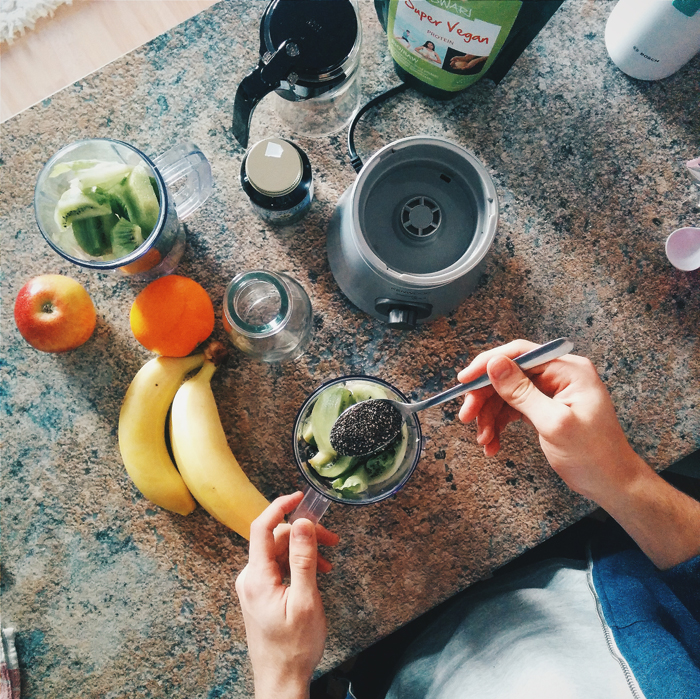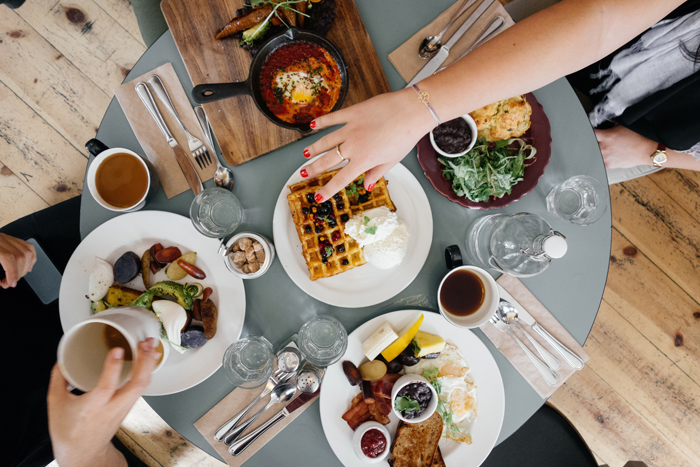Finding yourself in a food coma after a meal gets really old, really quick. Mindlessly eating and filling up on food just because it’s there is easy to do. But, like most things, habits can be overcome when you are aware of your behavior. If you’ve struggled with overeating, portion control or mindless munching – it’s time to rethink your eating habits and redesign your relationship with your meals. Here are some unique tips to help next time you find yourself going back for a second helping of mashed potatoes or scraping your big plate of casserole clean:
When at Home:
 Pack it up, pack it in – then you can begin
Pack it up, pack it in – then you can begin
As soon as your meal prep is complete, serve yourself and others around you, then pack up it up into tupperware right away. Leaving out your leftovers is a huge temptation to come back for seconds, when firsts are likely plenty to satiate. Cutting portions in a casserole or itemizing portions ahead of time — like in these stuffed bell peppers — can make portion control a cinch. Keeping your food fresh can also incentivize you to store it ahead of time, so you have a delicious lunch ready the next day. Be sure to use BPA and plastic-free containers when packing up your food — here’s why.
Red means “pump the brakes”
Green means go, yellow means slow down (in most cases – looking at you, you rule breaker) and red means S-T-O-P. These basic traffic signals have been ingrained in our minds since childhood. But, this logic may be just the trick to keep us from overeating. Studies have shown that we tend to consume less when eating off red plates or using red napkins. This subtle cue works on the subconscious and signals the brain to slow down and stop eating. In the market for new dinnerware? Check out this red set of dinnerware available at Target.
Switch your surroundings
Overeating is a habit: simply a behavior that’s on autopilot. Making a change to your environment may help keep you focused on the behavior of eating and make a conscious decision about what you consume. For example, if you always sit in the same seat at the dinner table or eat on the couch with a TV tray – switch it up! This slight change in your environment can empower you to be more mindful about overindulging. Check out our article on The Do’s and Don’ts of Mindfulness Nutrition to pick up some more tips on staying focused when eating.
 When at Work:
When at Work:
Breathe to avoid inhaling your lunch
When you’re preoccupied during a meal, your breath could be quick and tense. Check in on it when you sit down to eat. This can be a huge indicator that your body is moving quickly through the motions and not taking time to savor each bite. When scarfing down your food, you leave little time for your breath to catch up. By checking in on your breath, you can monitor how your body is reacting to the pace of the meal and ultimately keep track of how much you’re consuming.
Make your cup runneth over
Not with wine… not with soda… with water. A whopping 60% of the time we feel hungry, we’re actually thirsty. In fact, the average body needs approximately 64 oz of water per day — about half of your body weight in ounces — to be hit the holy grail of hydration. Dehydration can easily be confused with hunger and lead to low energy levels. Instead of jumping to the conclusion that you’re hungry and grabbing for the snack your secretary brought in, assess your water intake to keep that hungry feeling at bay. Then, if you’re still feeling the urge, grab something with high fiber or protein like hard-boiled eggs (6 grams of protein per egg) or a handful of raspberries (1 cup has 8 grams of fiber). Water bottles like this H2O Pal help you track your hydration throughout the day.
Visit the not-so-common common area
Eating at your desk is a recipe for a disaster. It’s the perfect scenario for mindless eating – consuming too much food and not being aware of it. Checking emails, surfing the web, and updating social media outlets are things we engage with when we’re eating at our desk. You need to be focused on your food to be in control of your intake. Try eating in a common area – away from your desk and in the company of others – that keeps your focus on the food and not on your work. You’ll feel more satisfied being cognizant of the food you consumed.
When Eating Out:
 Slurp on soup
Slurp on soup
Next time you’re out to eat, opt for soup as an appetizer and consider it half a meal. Once you do, you may be more inclined to order something less indulgent and still get the satisfaction of a full meal. For maximum nutritional and caloric value, try a vegetable or broth-based soup and steer clear of creamy ones (even though they’re oh-so-tempting). The soup will help fill and stretch your stomach before the meal, which will send signals to your brain to slow-down once your main course arrives. This will allow you to savor your entree and keep you from over indulging. Learn what soups fall into the broth-based category and what creamy soups to avoid next time you’re dining out here.
Gauge your hungry-o-meter
Hangry: when you become so hungry you get angry. This is one effect of waiting until you’re absolutely starving to eat. Another, is overdoing it. When you show up to a meal famished, your eyes become bigger than your stomach and you’re much more likely to overindulge. Again, getting enough fiber and protein in your diet should help hold over those hunger pangs until it’s actually time to eat. In the meantime, you can plan to have quality snacks throughout the day to keep your hunger at bay between meals.
Sharing is caring
Have you ever eaten out and ordered something that was large enough to feed an entire village? Don’t worry – we’ve been there too! That’s why it’s always important to ask about portion sizes. If you’re eating at a restaurant that’s notorious for large portions, try sharing your meal. This can help prevent you from clearing your plate and eating past the point of no return. Here’s proof that restaurant portions are exceeding nutrition recommendations; splitting a meal actually makes your meal a normal size.
___________________
Being mindful about your eating habits is the first step to kicking ‘em. Are you ready to take your eating habits into your own hands? Try implementing a few of these tips into your next few mealtimes and let us know if they worked for you in the comments below. Dig in!
Want more health hacks and wellness insights? We got you covered. You'll also receive a code for 15% off your first order!


Your bars are Perfect! I eat one a day on weight watchers one half at a time. They really stop hunger pangs and leave me feeling satisfied. And so good for you! I get mine at Costco.